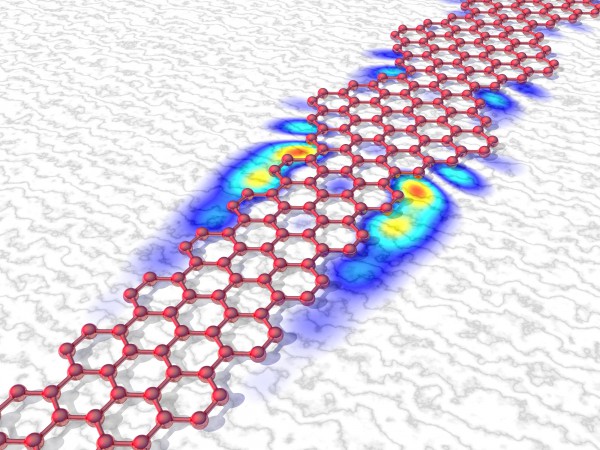Quantum chains in graphene nanoribbons
Reproduced from Karin Weinmann, Empa
Read the whole news story on the Empa Website.

When graphene nanoribbons contain sections of varying width, robust new quantum states can be created in the transition zone.
A material that consists of atoms of a single element, but has completely different properties depending on the atomic arrangement – this may sound strange, but is actually reality with graphene nanoribbons. The ribbons, which are only a few carbon atoms wide and exactly one atom thick, have very different electronic properties depending on their shape and width: conductor, semiconductor or insulator. An international research team led by Empa's nanotech@surfaces laboratory has now succeeded in precisely adjusting the properties of the ribbons by specifically varying their shape. The particular feature of this technology is that not only can the "usual" electronic properties mentioned above be varied – it can also be used to generate specific local quantum states.
So what's behind it? If the width of a narrow graphene nanoribbon changes, in this case from seven to nine atoms, a special zone is created at the transition: because the electronic properties of the two areas differ in a special, so-called topological way, a "protected" and thus very robust new quantum state is created in the transition zone. This local electronic quantum state can now be used as a basic component to produce tailor-made semiconductors, metals or insulators – and possibly even as a component in quantum computers.
The Empa researchers under the lead of Oliver Gröning were able to show that if these ribbons are built with regularly alternating zones of different widths, a chain of interlinked quantum states with its own electronic structure is created by the numerous transitions. The exciting thing is that the electronic properties of the chain change depending on the width of the different segments. This allows them to be finely adjusted – from conductors to semiconductors with different bandgaps. This principle can be applied to many different types of transition zones – for instance, from seven to eleven atoms.
"The importance of this development is also underlined by the fact that a research group at the University of California, Berkeley, came to similar results independently of us," said Gröning. The work of the US research team has been published alongside Gröning's in the same issue of Nature.
Continue reading the news on the Empa Website.
Low-volume newsletters, targeted to the scientific and industrial communities.
Subscribe to our newsletter